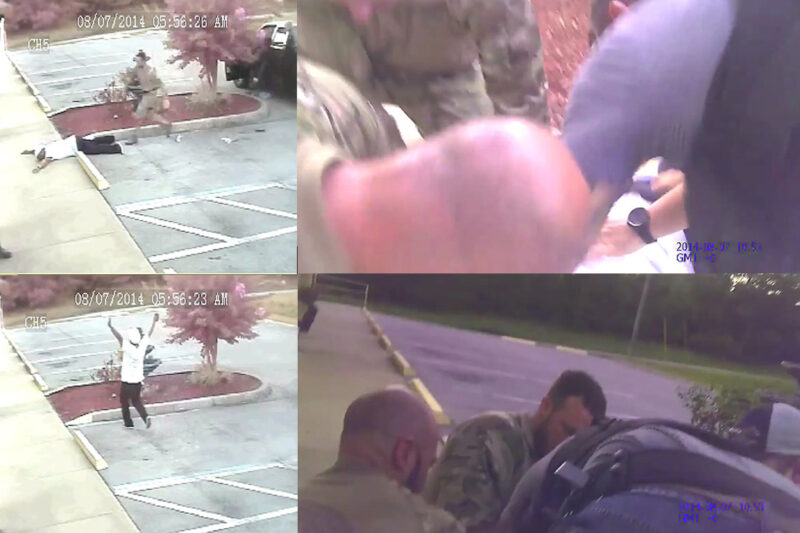
Last year I wrote about “acting and directing with police body cameras” — how police officers are likely to increasingly learn to manipulate the photographic record that their cameras create. A stark case study in that kind of manipulation can be found in video of a 2014 arrest in Florida that was released in January and recently came to my attention. It’s the kind of video that everyone should watch in order to become sophisticated and properly skeptical consumers of video evidence.
There are two videos of the arrest: footage from a nearby surveillance camera, and footage from a body camera worn by one of the officers. I could describe the video but it’s short, so I suggest you just watch it before reading further. A local NBC affiliate produced this 70-second produced package with explanatory voiceover, and the raw surveillance camera and bodycam footage is also online.
It’s hard to imagine what more a suspect could do to avoid being beaten by the police. Derrick Price not only puts his hands high in the air, he then proceeds to lie spread-eagle on the pavement before any of the Marion County sheriff’s deputies reach him. And yet the deputies beat him. What appears to be taking place in this video (as in many others, including the granddaddy of them all, the Rodney King video) is that police officers, angry at a suspect for fleeing (and perhaps disobeying previous orders to stop), have taken it upon themselves to punish the suspect for that disobedience. Punishment for crimes, including fleeing arrest and failure to obey a lawful order, is something we leave to the criminal justice system, which for all its problems has more due process procedures than the whims of angry policemen. The fact that five officers fell upon Price without hesitation or question suggests that such beatings may be routine. As I’ve written elsewhere, one of the things the video revolution in policing may be doing is exposing a disconnect between what a significant number police officers appear to view as standard, acceptable practice in dealing with suspects, and what the larger public views as proper and acceptable.
But the main reason I think this is a video everyone should watch is that the view provided by the surveillance camera is strikingly different from — and clearer than — the view provided by the body camera. The surveillance camera is higher up and, unlike the bodycam, captures the wide-angle of the scene. This is an important reminder of the limitations of cameras worn on the body of officers who are in the thick of the action.
But the difference between the two videos is also a result of intentional manipulation by the officers beating Price, who repeatedly yell “stop resisting!” as they kick and punch his unmoving body. And the body camera never properly captures the beating of Price, actually facing fully away from the action at some points. It is hard to tell how intentional this was on the part of the officer wearing the camera, but it’s easy to imagine that the officer knew that what his colleagues were doing was not acceptable, and intentionally sought to avoid videotaping them.
This tactic of yelling “stop resisting” when assaulting people who are not resisting appears repeatedly in videos from all across the country, which makes one suspect that the tactic is openly discussed and shared among police officers—and that this kind of abuse is disturbingly widespread.
Two other notes on the situation: first, while this video was finally released in compliance with Florida’s open-records law, it was kept secret for 16 months, an unjustifiably long time. Second, I would note that the camera was turned on very late into the incident, and turned off too early. Since this arrest followed a SWAT raid and a chase, under any good policy the officer’s camera should have been turned on long before the beating of Price began, and should have continued (as I discuss here and as we recommend) until “the encounter has fully concluded and the law enforcement officer leaves the scene.”
In our model policy we recommend strong action against officers who intentionally obstruct or interfere with their body cameras’ ability to accurately capture video, including a) appropriate departmental disciplinary action, b) a rebuttable evidentiary presumption in favor of defendants who reasonably claim that exculpatory evidence was destroyed or not captured, and c) a similar presumption in favor of plaintiffs suing over police misconduct.
Price was very lucky, and the officers unlucky, that the arrest took place in clear view of a surveillance camera. If the bodycam footage was the only evidence, the deputies’ subsequent lies about Price’s alleged violent resistance to his arrest would almost certainly have been believed.
At the same time, for those skeptical of body cameras it’s worth noting that he would likely have been no worse off with only the bodycamera video than he would have been with no video at all. Or, if every officer at the scene wore a camera, the situation would likely have also been clear — or, with the deputies knowing they were being recorded, wouldn’t have happened at all.
But it did, and the divergence between the two video streams that captured the arrest serves as an important lesson and reminder of the limits of video evidence, as well as the need for skepticism toward police accounts of what such videos portray.




